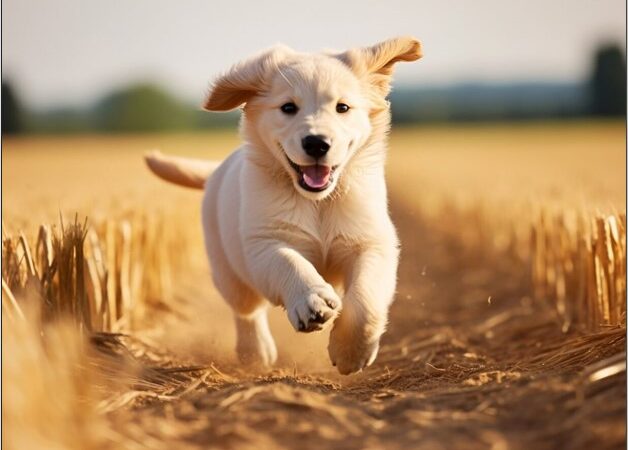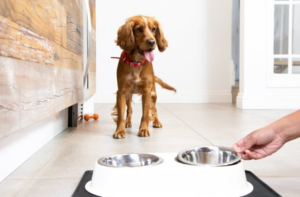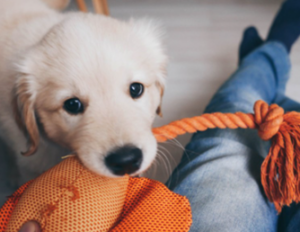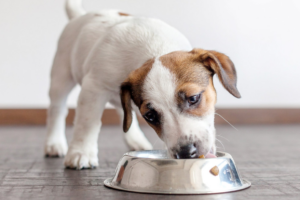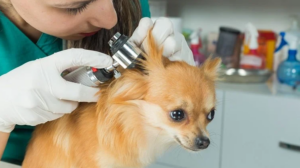How to be Prepared
Puppies find many of the ordinary things that we see (and ignore) everyday very exciting. That pot plant, those socks, that power cable might be boring to you, but they’re fascinating to them. So before you bring your new puppy home it’s worth taking the time to look around your house from their perspective.
Start by deciding what rooms you’ll allow your new dog into. Any space where they’ll be spending time needs to be vetted–including garages and yards. Once you’ve assigned your dog-friendly zones, review them with an eye out for the following items. Any dangerous objects should be removed or placed somewhere high out of reach.
Cleaning products and medications
Be very conscious of your cleaning products, medications, household poisons (such as weed killer or rat bait), fertilisers, insecticides, or paints. Think, would I want to eat that? If the answer is “no way” then store them in a locked cupboard or on a high shelf.
Plants
Many popular house and garden plants can be dangerous to dogs if ingested. Look up the plants you have around your home to see if they’re toxic to pets. If so, make sure they’re removed or out of reach. Click here to view a list of poisonous plants, garden and household substances. This list is provided by Dogs Trust.
Items on the floor
Pick up anything that may be small enough for them to swallow. This includes things like shoes, socks, rugs, pillows, homewares, and objects with small parts they could gnaw off. Remember, you can’t be too careful. Even soft objects can cause issues.
Don’t forget the garden
All the above watch-outs also apply to outside areas. Make sure any garden, courtyard, or balcony is fenced and secure with no holes where pets could escape. Pool fencing is also a must, along with a pool cover.
Think about their sleeping area
Pay extra attention to where your pet sleeps to make sure it’s safe and secure. Small rooms, crates, and pens are all good options. But wherever you choose, ensure it’s not in a thoroughfare or an area where there is a lot of movement. You don’t want them to be constantly disturbed, tripped over, or stepped on.
Playpen, Crate & Baby gates
If you want to keep your dog away from dangerous areas for a short period of time or when you’re not around (say if you’re doing house work that involves chemicals), consider using a crate or playpen. To make areas of your home permanently pet-free, you can set up a baby gate.
Keep things closed
Doors and cupboards aren’t the only things to keep in mind. Also ensure that washing machine and dryer doors, rubbish bins and toilet lids are all secured too. Trust us, if it’s possible, they’ll find a way to get in.
Bringing your Puppy Home
The first time you bring your dog home is a chance to set the mood for their whole life with you. Whether they’re a puppy or a rescue coming from unknown or stressful circumstances, positive introductions can set them up for success in the long run.
Some fundamentals to remember:
- Before you let your pet into a new area make sure they’ve been to the toilet. It sounds simple but this small step can prevent a lot of accidents.
- Establish rules early and be proactive. Know where they’re going to sleep and eat, and have clear plans for what their days will look like. For example: If you don’t want them to beg at the dinner table, feed them their meals at the same time you’re eating yours. Be consistent and keep it up. Too much free reign, or breaking routines, sets them up to fail and pick up bad habits.
- Have your home set up for them before they arrive. That means pre-organising bedding, food, toys and chews, water bowls, and some treats so they walk into a consistent, calm environment.
- Know what associations you want them to have with each area of your home and reinforce them. For example: You probably want the living room and bedrooms to be spaces where your pet is relaxed and settled. So avoid leaving toys such as balls and squeakers around, and rather provide bedding and chews in these rooms.
- Introducing them slowly, moving one room at a time. Too much too soon can be overwhelming and cause them to get overstimulated. The goal is for them to learn calm and positive associations with each space. Let them sniff and explore before removing them to where they are going to sleep or allowing them to rest in the room itself.
- You don’t have to introduce them to the whole house in one go. Absorbing new information is exhausting. Watch and respond appropriately to your dog’s body language. If they become agitated, distracted, or hyper-aroused it means their mind is racing. Take time to settle things down using gentle encouragement and chews. If you need to pause and come back to the rest of the home later that’s fine.
- Lift up or remove anything you don’t want your dog to have access to BEFORE they come home. If you can’t remove it, then coat it with a chewing deterrent so they learn as early as possible to not put their mouth over it.
- Introduce family members one at a time. Each interaction is a conversation, and it’s easier to focus one-on-one. The same rule goes when introducing them to other animals. Ensure both parties feel comfortable in the environment before trying a face-to-face meeting. Let one pet into a space alone, remove them, then bring in the other. The goal is to let them have a sniff before they meet. They don’t need to be in the same room to start getting acquainted.
- Positive experiences do not have to be over-stimulating. If your dog is calm, content, and showing no signs of stress, they’re happy. This is a great frame of mind to remember for the home environment. Getting them worked up through play and boisterous interactions may be fun but is it really what you want them to learn about being at home? Nobody has ever called a dog trainer because their dog is too relaxed.
- It takes roughly three months for a dog to understand that this new space is home. They have strong cyclical memories and remember patterns such as when you get up, go to work, take walks, and feed them. But they need repetition to learn and can be thrown off by changing routines–so be consistent.
The awkward truth is that in these first months your dog doesn’t know for sure it’s safe. Their nervous system will be firing on all cylinders as they constantly anticipate change and learn how to fit into this new human world. Give them time to learn, relax, and digest all this information. No wonder dogs need to sleep for 18 hours a day. All that learning is tiring.
A crash course in puppy health essentials
We all want our pups to never grow up. But the reality is they grow incredibly fast. Which is why it’s so important to look after their health when they’re young to set them up for a healthy and happy life.
Puppy Food Vs Adult Food
Do puppies really need special food? Absolutely. Not only do growing dogs have more energy requirements compared to adult dogs of the same size, they also have higher needs for key nutritional building blocks. Puppy food should contain additional protein for healthy muscles and organs, fat for energy, and calcium and phosphorus for bones. As well as specific omega 3s (ALA, EPA, DHA) to help brain development. It takes lots of neurons to learn toilet training, tricks, and how to make you do exactly what they want!
Because of these complex requirements, if you decide to make your dog’s food rather than buying it from a trusted brand, you need to get advice from your vet or animal nutritionist.
Some high-quality dry dog food is designed for both puppies and adults. The key is to look for claims like “nutritionally complete for all breeds and life stages”.
We like to suggest getting a mixed box (you can choose that at checkout) to expose your dog to different proteins and ingredients in order to see if they may need a dog food for allergies. You’ll also help to build up communication with your puppy and learn what they like.
Feeding time
Puppies need to eat more often than adults. A 10 week old pup needs four meals a day. After four to six months they can move to three meals a day. Once their growth starts to slow you can drop to twice a day.
Exercise
It will take a while until your puppy can double as a running buddy or yoga partner. They need time to grow into their body. Young puppies might be yogi flexible, but their joints, muscles, and tendons have to strengthen. Start with short walks and try not to encourage too much jumping or running until they’re a bit older. This is a good conversation to have with your vet and breeder as early exercise levels vary greatly between breeds. Maxizoo provide advice on how to exercise your dog and keep it mentally healthy – view advice here.
Teeth
Just like us, your puppy will start with baby teeth. Beware, they’re needle-sharp. You want them to learn quickly that you and your family are not on the menu. There are multiple training methods to do this, and you need to decide early what style works best for you and your pet.
While you can teach an old dog new tricks, puppyhood is the perfect time to normalise behaviours you want to encourage later in life. For example: if you regularly brush your dog’s teeth when they’re young, it’s more likely they’ll enjoy it when they’re older.
Also, don’t get too alarmed if you see some little teeth laying around. They start losing their baby teeth from around four months old.
How often should a dog visit the vet?
As pets can’t talk and age faster than we do, we recommend seeing your pet at least once every 12 months. That’s if they have no health concerns. We recommend for dogs over seven years old to have an examination every six months as they are considered “seniors”.
Like with humans, some health issues can make your pet acutely unwell or they can deteriorate quickly. Regular check-ins let us find problems and detect abnormalities so we can act on them fast.
When should a puppy have their first appointment?
Ideally within the first two weeks of ownership. This way we can give your puppy a full health examination, discuss nutrition, parasite and vaccination schedules, and provide other tips to help you as an owner. There is a lot of information out there, so speaking to a professional about this can help cut out irrelevant and overwhelming information.


